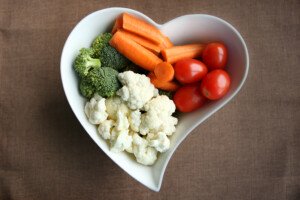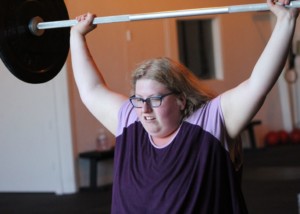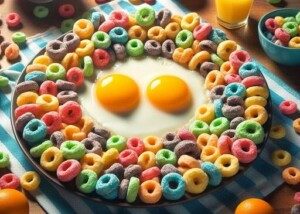
Why do women feed their Prader-Willi kids cereal for breakfast?
I was inspired to write this article after reading about a women whose 14-year-old daughter weighs 343 pounds (as of August 2014).
Hannah has Prader-Willi syndrome. If you clicked on this article, you know what PWS is, so I won’t explain it.
What puzzles me is why Hannah’s mother gives her cereal for breakfast. You don’t get a lot of bang for your buck with cereal. Three-quarters’ cup may be 120 calories—and then there’s the milk.
Cereal is a highly processed food that’s loaded with simple carbs. All Hannah gets is one cup. Then she’s done. “When’s the next meal?”
Americans are brainwashed into feeding their kids—PWS or healthy—cereal for breakfast. But cereal is not a health food.
Why not feed Hannah three cups of food for breakfast—but instead of something that comes from a manufacturing plant, how about something that comes from a real plant?
How about one bowl of diced carrots and celery; a second bowl of sliced cucumbers, tomatoes and cauliflower; and a third bowl of radishes and beets?
You’re probably thinking, “Ugh, you can’t expect a teenager or younger child to eat THAT for breakfast!”
But Hannah has eaten dog biscuits. Another Prader-Willi child I’ve read about would eat soap.
Do enough reading about what kids (and adults) with Prader-Willi syndrome will eat when not supervised, and you’ll come upon all sorts of things, like vegetable oil, jars of mayonnaise, sticks of butter, raw meat, even cardboard.
So if someone with PWS will eat these kinds of items, I’d think that several bowls of fresh vegetables would be most palatable, especially if they’re seasoned.
Three bowls of the aforementioned vegetables and fruits (tomatoes and cucumbers are fruits) equal the same calories as one cup of cereal—without the milk.
Raw produce is loaded with enzymes and natural antioxidants. Three bowls of the produce are far more healthful than the cereal.
And from a psychological perspective, the three bowls are far more satisfying because it would take longer to eat this tripled volume.
There’d be a lot of chewing. There’d be different colors, tastes and textures. Lots of crunching.
Hannah and others like her would be less inclined to be begging when their next meal is.
I’ve read about PWS kids being fed three meals a day and two snacks. Cassidie gets only four feedings a day—it’s spelled out on her Facebook page (run by her mother).
I realize that at only age seven, Cassidie can’t have more than around 900 calories a day or she’ll put on a lot of weight.
But she’d be able to have additional feeding times if some of the “regular” food was converted to vegetables.
And why do Prader-Willi kids get juice? Juice is loaded with calories. Even “normal” people, who want to lose weight are advised never to drink calories—to drink only water or Stevia-sweetened beverages—and CHEW calories!
Juice is gone in seconds: Bang, just like that—100 calories! For the same 100 calories, a person with Prader-Willi syndrome could be biting into, chewing and swallowing several cups of carrots, celery, radishes, cauliflower and broccoli.
Why give them juice? Is that necessary? No. Is the cereal necessary? No.
But cereal and juice are heavily marketed towards parents, so they’re brainwashed into thinking that if they don’t give their kids cereal and juice—they’re depriving them of something beneficial.
A child with the life-threatening disease of Prader-Willi syndrome needs a different set of rules.
A cup of the lowest calorie raw produce every two hours will surely eliminate the constant “When’s my next snack?” and provide a psychological type of satiation with all the biting into, crunching and chewing.









































